Welcome to Indiana, home to some of the most beautiful blue birds in the United States! These birds have a long and storied history in the Hoosier State, providing a colorful addition to many Indiana landscapes.
Blue birds have been a part of Indiana’s history since the 19th century, and today they are a beloved symbol of the state’s natural beauty. From the bluebird’s song to its vivid blue plumage, these birds have captivated generations of Indiana residents and visitors alike.
With the help of conservation efforts, the population of blue birds in Indiana continues to increase and thrive. In this article, we’ll explore the history, habitat, and population of blue birds in Indiana. So read on and learn more about these beloved feathered friends.
1. Eastern Bluebird
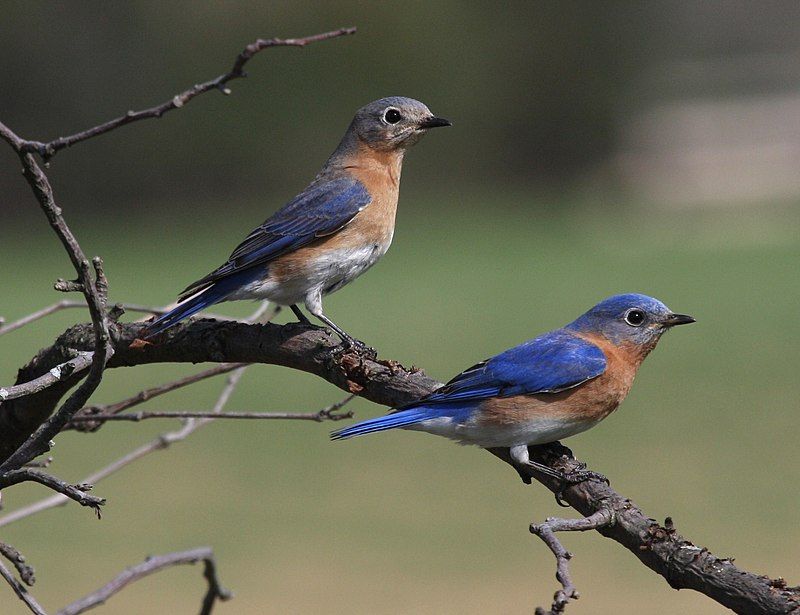
The eastern bluebird is a small North American thrush that migrates seasonally. They are typically found in areas with open woodlands, farmlands, and orchards. The male has a particularly vibrant blue plumage, which makes them easy to spot on a wire or open perch.
This makes it a popular bird to observe for birders. During the breeding season, the male’s bright blue feathers can be seen from a distance, and they are often found perched on telephone wires or in open fields.
While the female has a more modest brownish-gray body, she is still an interesting sight. The eastern bluebird is an important part of the ecosystem, as they are a keystone species that helps to keep insect and other pest populations in check.
They also have a unique and beautiful song that helps to bring joy to the environment. The eastern bluebird is a species worth protecting, and it is important to support their habitats and ensure their safety.
| Kingdom | Animalia |
| Phylum | Chordata |
| Class | Aves |
| Order | Passeriformes |
| Family | Turdidae |
| Genus | Sialia |
| Species | S. sialis |
2. Blue Jay
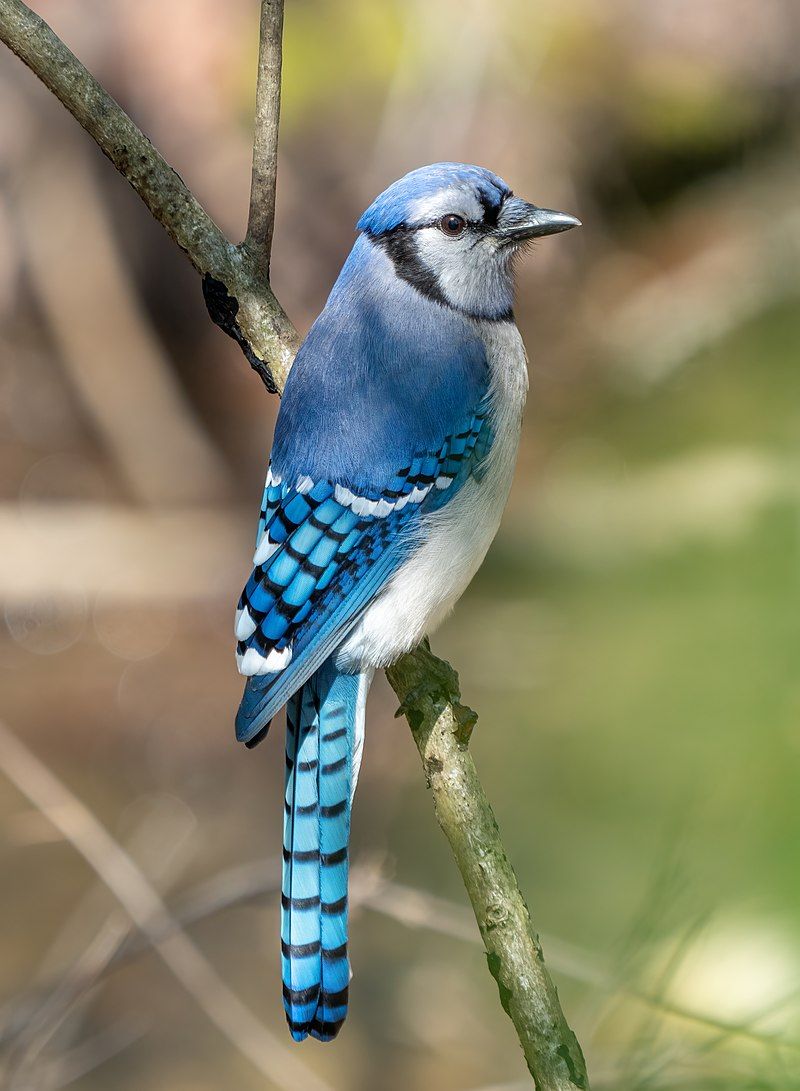
The blue jay is a type of songbird belonging to the Corvidae family. It is native to eastern North America, where it can be found in most of the eastern and central United States.
Some parts of the eastern US may be the site of migratory populations of blue jays, while other areas may have permanent resident populations. In addition, blue jays can be found in Newfoundland, Canada, and there are breeding populations of the species across southern Canada.
The blue jay is known for its striking blue plumage and its loud, harsh vocalizations. It is an omnivorous bird, and its diet consists of both plant-based and animal-based food items.
The bird is also a keystone species in many ecosystems, as it plays an important role in seed dispersal and insect control.
| Kingdom | Animalia |
| Phylum | Chordata |
| Class | Aves |
| Order | Passeriformes |
| Family | Corvidae |
| Genus | Cyanocitta |
| Species | C. cristata |
3. Indigo Bunting
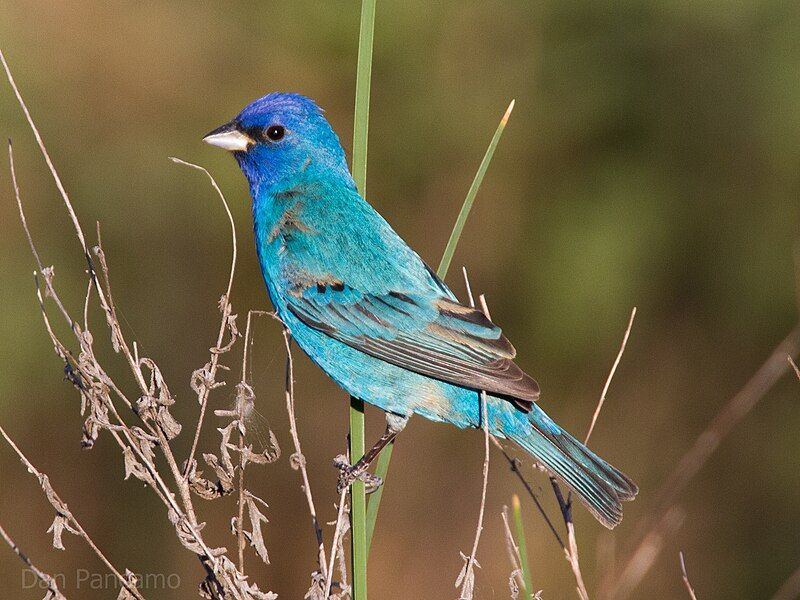
The indigo bunting is a small bird that belongs to the Cardinalidae family, which consists of seed-eating birds. This species is migratory, meaning it moves from one place to another depending on the season.
During the summer months, it can be found in areas ranging from southern Canada all the way down to northern Florida. When winter arrives, it travels to southern Florida and northern South America. To get from one place to another, the indigo bunting usually migrates by night.
By doing so, the bird is able to use the stars to find its way and navigate successfully. This behavior is an amazing adaptation that has allowed the species to persist and thrive over time.
| Kingdom | Animalia |
| Phylum | Chordata |
| Class | Aves |
| Order | Passeriformes |
| Family | Cardinalidae |
| Genus | Passerina |
| Species | P. cyanea |
4. Cardinalidae
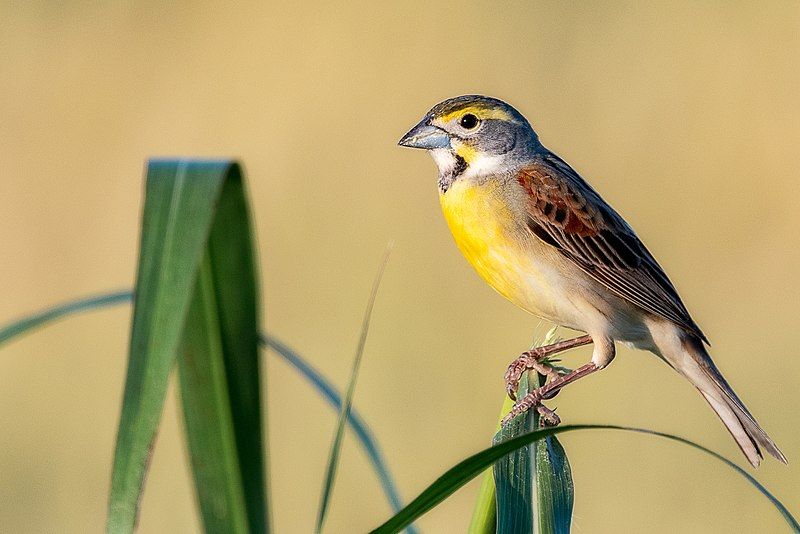
Cardinalidae is a family of birds that are found exclusively in the New World. This family includes cardinals, grosbeaks, and buntings. These birds all have similar characteristics, such as strong, conical beaks and short, rounded wings.
Additionally, Cardinalidae also includes several other genera, such as the tanager-like Piranga and the warbler-like Granatellus.
Tanagers are brightly colored, medium-sized birds that can be found in Central and South America, while warblers are small, insectivorous birds that are found in North and Central America.
The Piranga and Granatellus both have traits that make them unique, with Piranga having a distinct head shape and Granatellus having a long, slender bill.
All members of the Cardinalidae family have a strong presence in the Americas, and they are vital to the local ecology of the region.
| Kingdom | Animalia |
| Phylum | Chordata |
| Class | Aves |
| Order | Passeriformes |
| Family | Cardinalidae |
5. House Finch
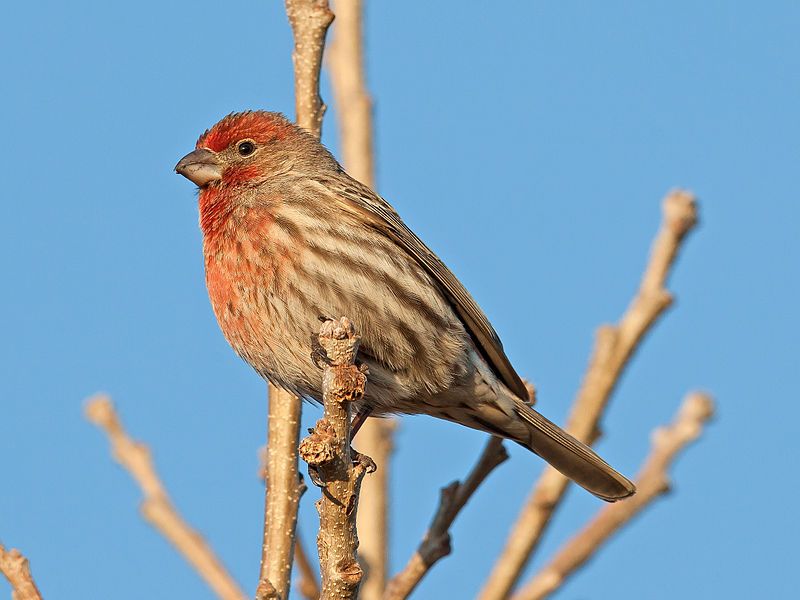
The house finch is a species of bird in the finch family, Fringillidae. This bird is native to western North America, but it has been introduced to the eastern half of the continent and Hawaii. It is one of three American rosefinches, which are placed in the genus Haemorhous.
This genus is in the finch family, alongside other species such as the purple finch and the Cassin’s finch. The house finch is a small bird with a reddish-brown head and back, and a white belly. It has a short, pointed bill and a long tail.
The male house finch typically has brighter plumage than the female, with a more brightly colored chest and face. This species is often found in open areas such as meadows, fields, gardens, and parks. House finches feed on seeds, grains, and fruits.
They also eat insects, which they catch with their short, pointed bill. In the winter, these birds often form large flocks and migrate south in search of food. They build their nests in trees, shrubs, and other sheltered places, usually in colonies.
The female house finch lays two to five eggs at a time, which both parents help incubate. The house finch is an important species in the bird world, not only because of its beauty but also because it is an important part of the ecosystem.
Its presence helps maintain balance in the food web by providing food to predators, and it also helps to disperse seeds and pollen. Therefore, it is important to protect these birds and their habitats in order to maintain a healthy bird population.
| Kingdom | Animalia |
| Phylum | Chordata |
| Class | Aves |
| Order | Passeriformes |
| Family | Fringillidae |
| Genus | Haemorhous |
| Species | H. mexicanus |
6. White-Breasted Nuthatch
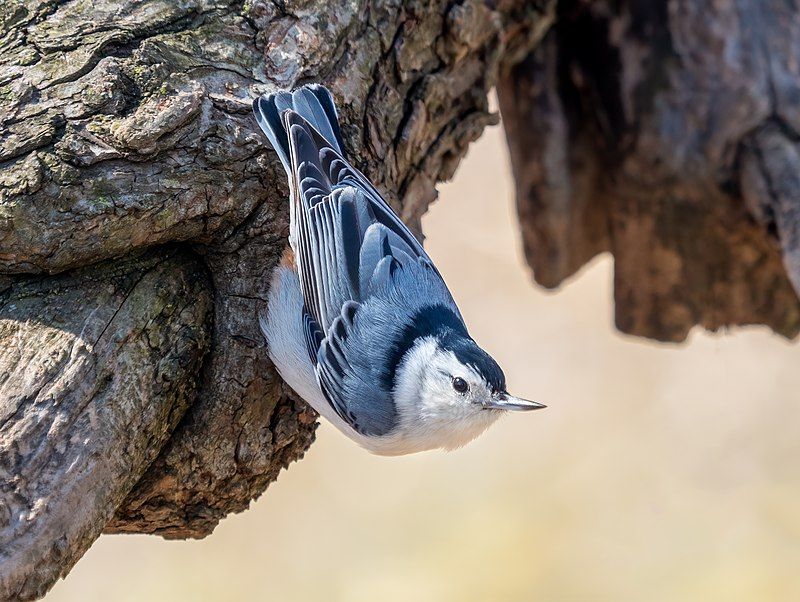
The white-breasted nuthatch is a species of bird that belongs to the nuthatch family, Sittidae. It is a medium-sized bird, measuring about 15.5 cm in length, and is characterized by its distinct white breast.
The bird has a large, strong bill, a long neck, and short, rounded wings. Its tail is short and its legs are short but strong. Its back is usually grayish-brown in color, while its underparts are white or pale gray.
The white-breasted nuthatch is found in woodlands and coniferous forests throughout North America and is a popular backyard bird in parts of the United States.
It is a shy species, often seen perched on the side of a tree, and it is an active forager, often seen climbing up and down trees in search of food. Its diet includes a variety of insects, berries, and nuts.
It is known to store food for later consumption, and it is also known to occasionally cache food inside tree bark. The white-breasted nuthatch is a vocal bird, and its call is a series of loud, high-pitched whistles.
It is an important part of the local ecology, and it is an important species to help maintain healthy woodland habitats.
| Kingdom | Animalia |
| Phylum | Chordata |
| Class | Aves |
| Order | Passeriformes |
| Family | Sittidae |
| Genus | Sitta |
| Species | S. carolinensis |
7. Common Grackle
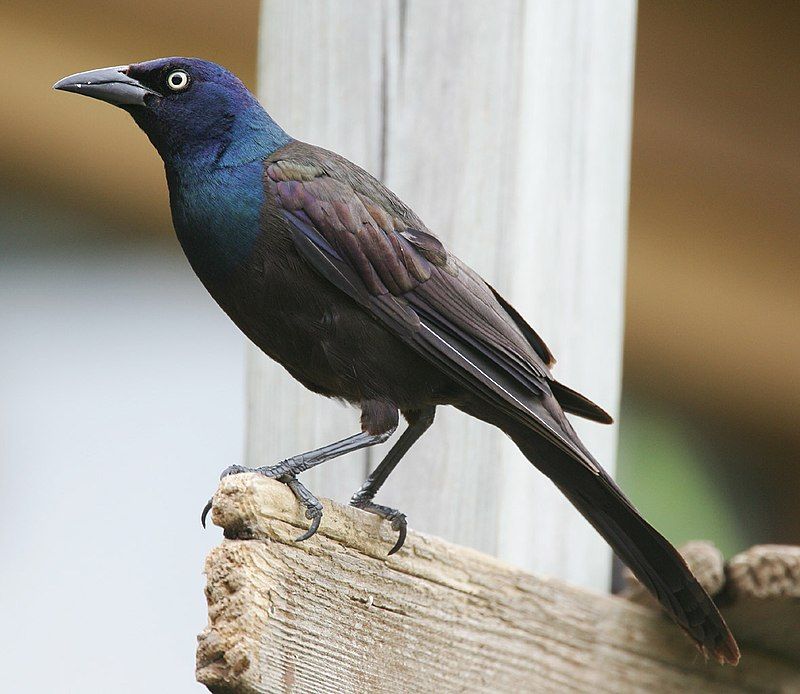
The common grackle is a species of large icterid bird found in many parts of North America. It was first described in 1758 by the famous Swedish biologist Carl Linnaeus. The common grackle has three recognized subspecies, each with distinct physical features.
Adult common grackles have long, dark beaks and pale yellow eyes. They also have a long and pointed tail which can be used for balance when they are flying. The common grackle is usually found in flocks and can be identified from its loud call.
They live in open woodlands and grasslands, and can often be seen near water sources such as lakes and rivers. Their diet consists mainly of insects, but they will also consume fruits, seeds, and other small animals.
The common grackle is an important part of the North American ecosystem and plays an important role in controlling the population of certain insect species.
| Kingdom | Animalia |
| Phylum | Chordata |
| Class | Aves |
| Order | Passeriformes |
| Family | Icteridae |
| Genus | Quiscalus |
| Species | Q. quiscula |
8. Red-Breasted Nuthatch
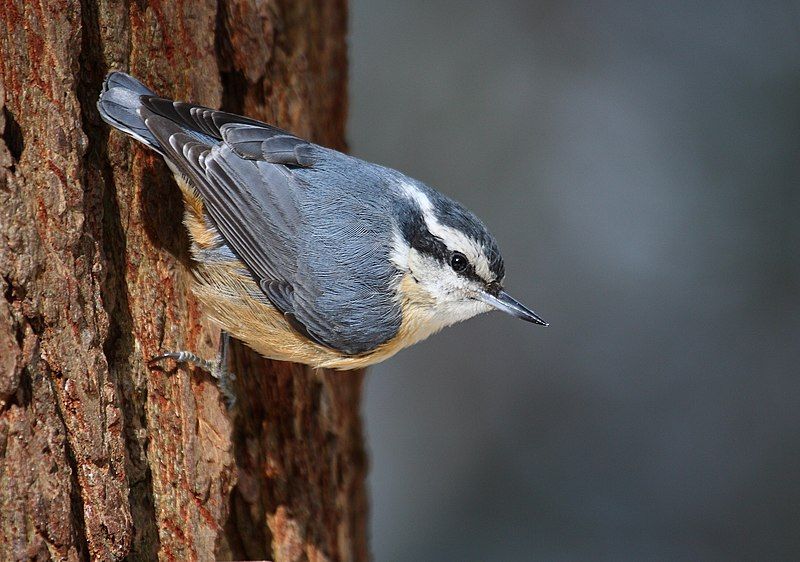
The red-breasted nuthatch is a small songbird with distinct features. Its upperparts are a vibrant blue-grey while its underparts are a warm cinnamon color. Its face is white with a black stripe running through its eyes and a grey bill that sits atop its head.
The black crown adds a regal touch to complete the bird’s look. The red-breasted nuthatch is known for its distinct call that has been likened to a tin trumpet. The high-pitched and nasal sound is often heard in woodlands and other natural areas.
The call of the red-breasted nuthatch is one of the defining features of this species, making it easily recognizable in the wild.
| Kingdom | Animalia |
| Phylum | Chordata |
| Class | Aves |
| Order | Passeriformes |
| Family | Sittidae |
| Genus | Sitta |
| Species | S. canadensis |
9. Cerulean Warbler
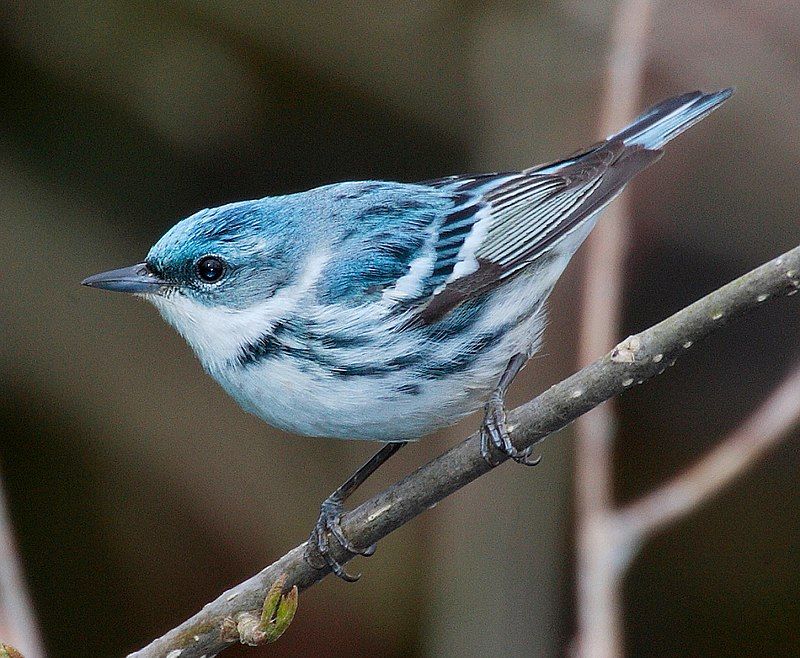
The cerulean warbler is a small, vibrant songbird that belongs to the Parulidae family. This species is a long-distance migrant, breeding in hardwood forests located in the east of North America.
During the winter season, the cerulean warbler migrates to the eastern slopes of the Andes in South America, where it prefers to inhabit subtropical forests. This species is a long-distance migrator, which is quite rare among birds.
In order to survive the intense winter climate, the cerulean warbler must build up enough fat reserves to sustain its long journey. This species is also a very important part of the ecosystem, as it plays an important role in pollination and seed dispersal.
The cerulean warbler is a beautiful and unique species that deserves to be admired and protected.
| Kingdom | Animalia |
| Phylum | Chordata |
| Class | Aves |
| Order | Passeriformes |
| Family | Parulidae |
| Genus | Setophaga |
| Species | S. cerulea |
10. Blue-Gray Gnatcatcher
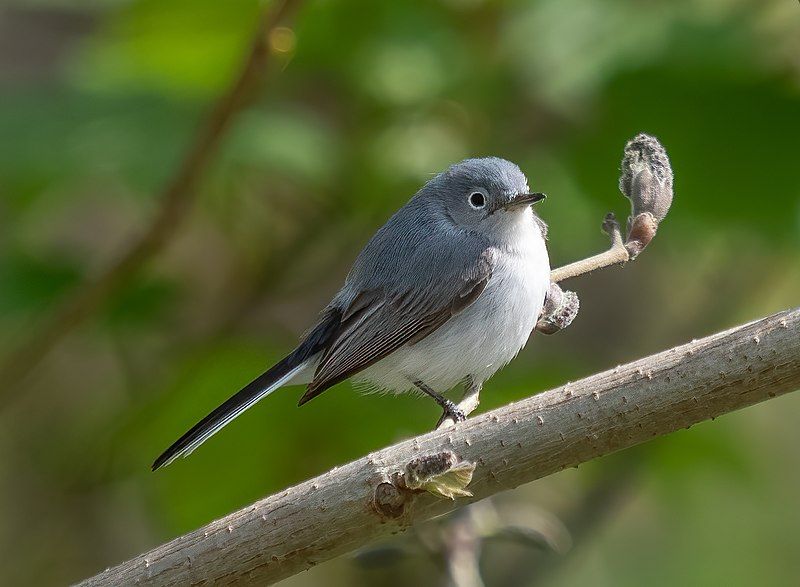
The blue-gray gnatcatcher is a small songbird native to North America. It is a member of the family Polioptilidae, which is made up of small passerines.
The bird is mainly blue-gray in color, with white underparts and a white eyebrow, and can grow up to four and a half inches in length. It has a short, thin bill and long tail feathers, and it hops on the ground like a sparrow.
It is a migratory species, spending the summer months in the northern parts of the continent and heading south for the winter. Its diet consists of small insects, spiders, and other invertebrates, which it catches by hovering and darting over the ground or vegetation.
The blue-gray gnatcatcher is an important species for conservation, as its populations are declining due to habitat destruction, pollution, and other human activities.
It is also a favorite among birdwatchers, as its bright colors and active behavior make it a pleasure to observe.
| Kingdom | Animalia |
| Phylum | Chordata |
| Class | Aves |
| Order | Passeriformes |
| Family | Polioptilidae |
| Genus | Polioptila |
| Species | P. caerulea |
11. Black-Throated Blue Warbler
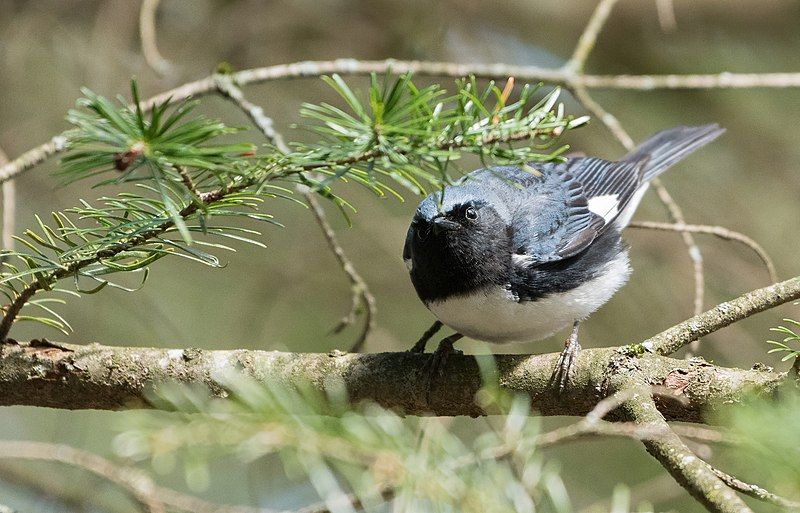
The black-throated blue warbler is a type of small bird in the family of New World warblers. It is found mainly in eastern North America in deciduous and mixed coniferous forests.
These warblers have adapted to the climate of the area and reside there throughout the summer months. As the weather cools, they migrate to the warmer islands of the Caribbean and Central America.
This species of warbler is unique in its ability to travel long distances for its winter migration. It is believed that the birds use the warm air currents of the Gulf Stream to assist them in their long journey.
Once the warm season returns, they return to the forests of North America to breed and raise their young. The black-throated blue warbler is a fascinating species of bird that has adapted to the changing climate of its environment.
| Kingdom | Animalia |
| Phylum | Chordata |
| Class | Aves |
| Order | Passeriformes |
| Family | Parulidae |
| Genus | Setophaga |
| Species | S. caerulescens |
12. Purple Martin
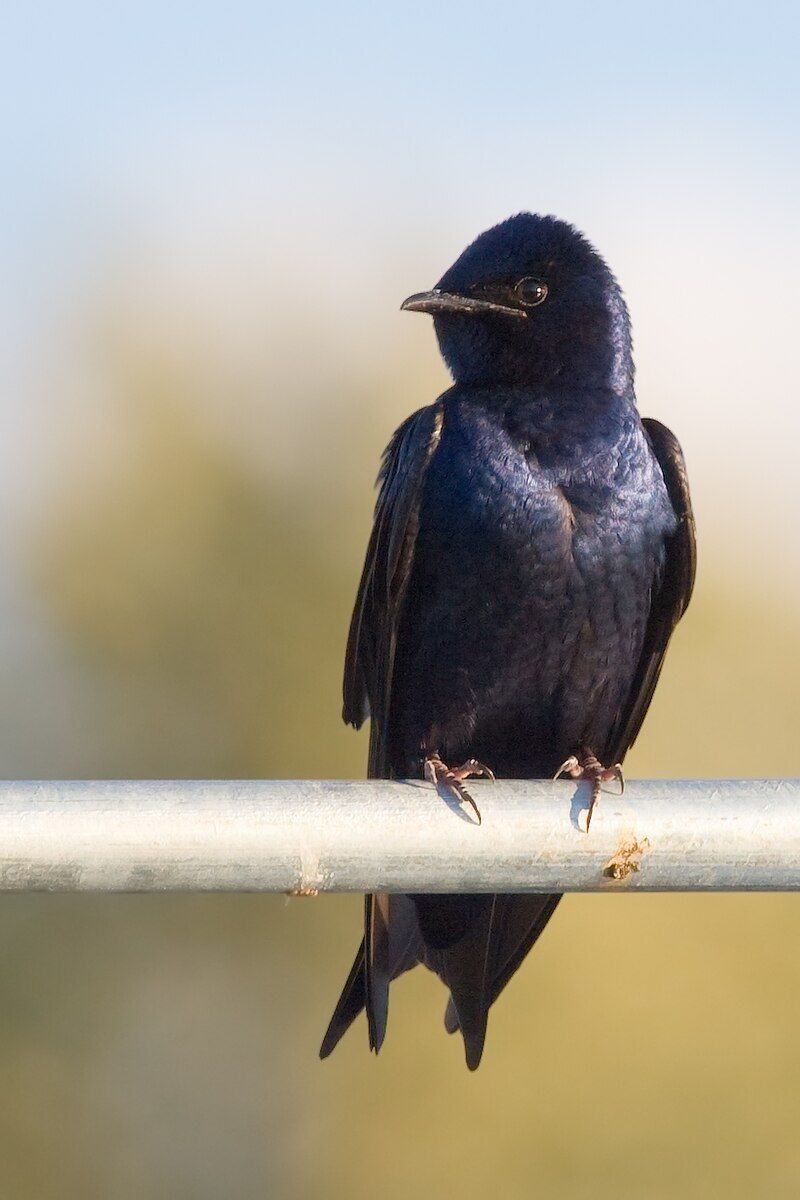
The purple martin is a type of passerine bird, which is in the family Hirundinidae. It is the largest swallow among the birds found in North America, however, it is not actually purple in color. Instead, it is a mixture of blues, purples, and even some grays.
The purple martin has a long, pointed wingspan and a forked tail, both of which help it to fly quickly and efficiently. Its diet consists mainly of flying insects and it is commonly found in open areas near water, particularly near marshes and wetland areas.
The purple martin is an incredibly important species for its help in controlling insect populations, as well as its beauty and its song.
| Kingdom | Animalia |
| Phylum | Chordata |
| Class | Aves |
| Order | Passeriformes |
| Family | Hirundinidae |
| Genus | Progne |
| Species | P. subis |
13. Painted bunting
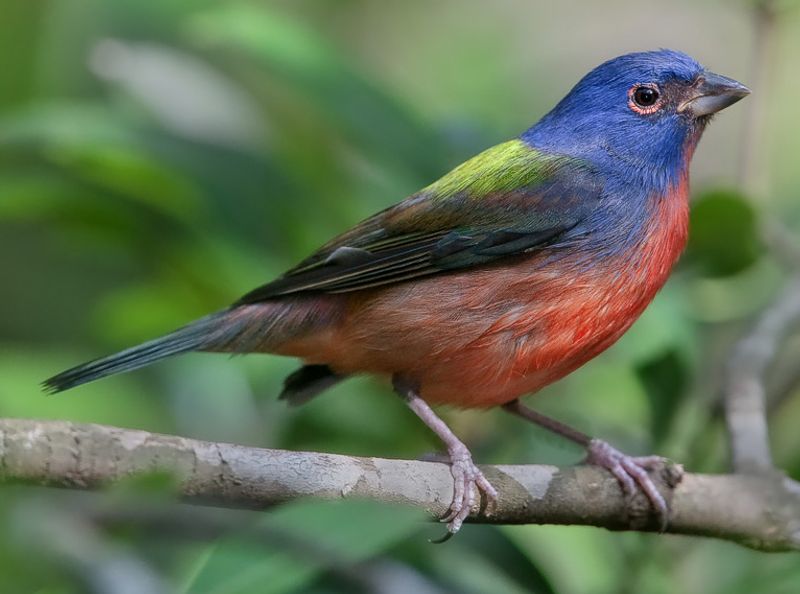
The painted bunting is a species of bird belonging to the Cardinalidae family, which is native to North America. This bird is easily distinguished by its bright plumage, which is unique to the male species.
However, this plumage does not develop until the second year of life; in the first year, the male and female can only be identified through close inspection. This means that the painted bunting is a species that undergoes a dramatic change in physical appearance as it matures.
The male’s plumage is particularly remarkable, as it changes from a dull gray in the first year to vibrant shades of red, green, yellow, and blue in the second year. This transformation from a drab gray to a bright rainbow of colors is a remarkable example of nature’s beauty.
| Kingdom | Animalia |
| Phylum | Chordata |
| Class | Aves |
| Order | Passeriformes |
| Family | Cardinalidae |
| Genus | Passerina |
| Species | P. ciris |
14. Blue grosbeak
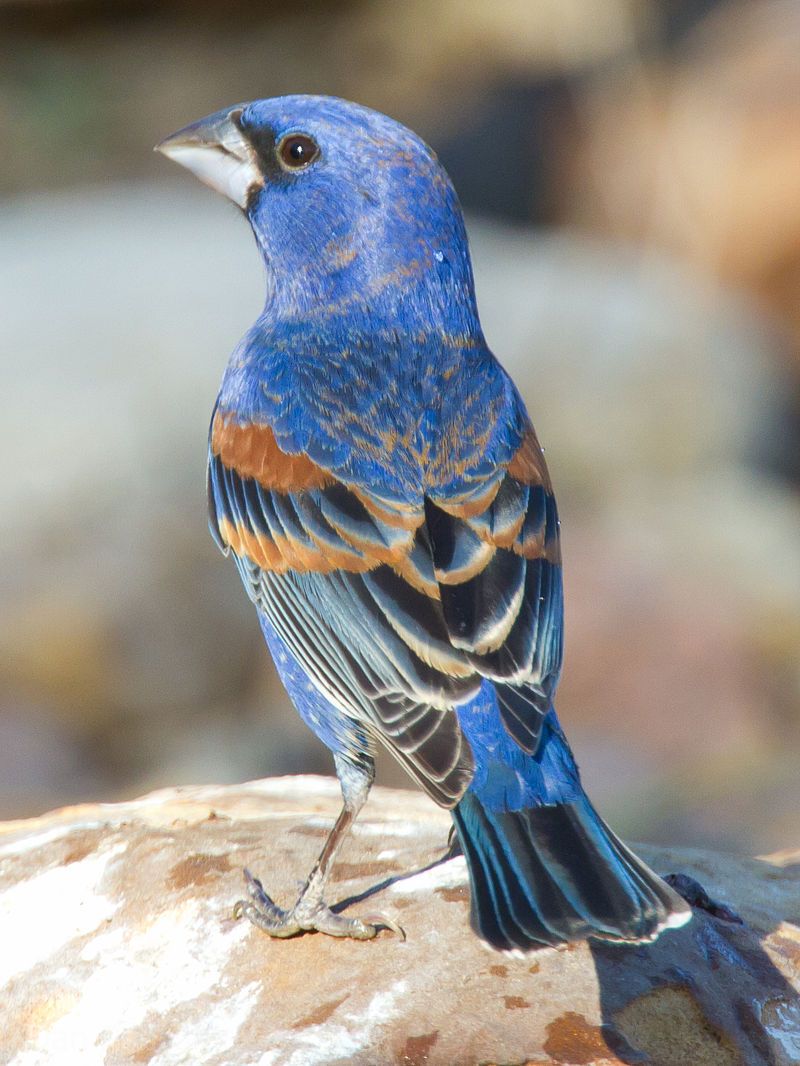
The blue grosbeak is a species of bird belonging to the Cardinalidae family, which is a group of medium-sized passerines that are mainly found in North America. This bird is known to be migratory, which means that it travels from one place to another in different seasons.
During the winter months, it can be found in Central America, while during the summer months, it travels north to breed in northern Mexico and the southern United States.
The male blue grosbeak is easily identifiable due to its brightly-colored plumage, which is predominantly blue in color, with two brown wing bars. These wing bars are believed to help the bird better identify its own species during flight.
It also has an orange-colored bill and bright yellow eyes, making it a very attractive species of bird.
| Kingdom | Animalia |
| Phylum | Chordata |
| Class | Aves |
| Order | Passeriformes |
| Family | Cardinalidae |
| Genus | Passerina |
| Species | P. caerulea |
15. New World Warblers
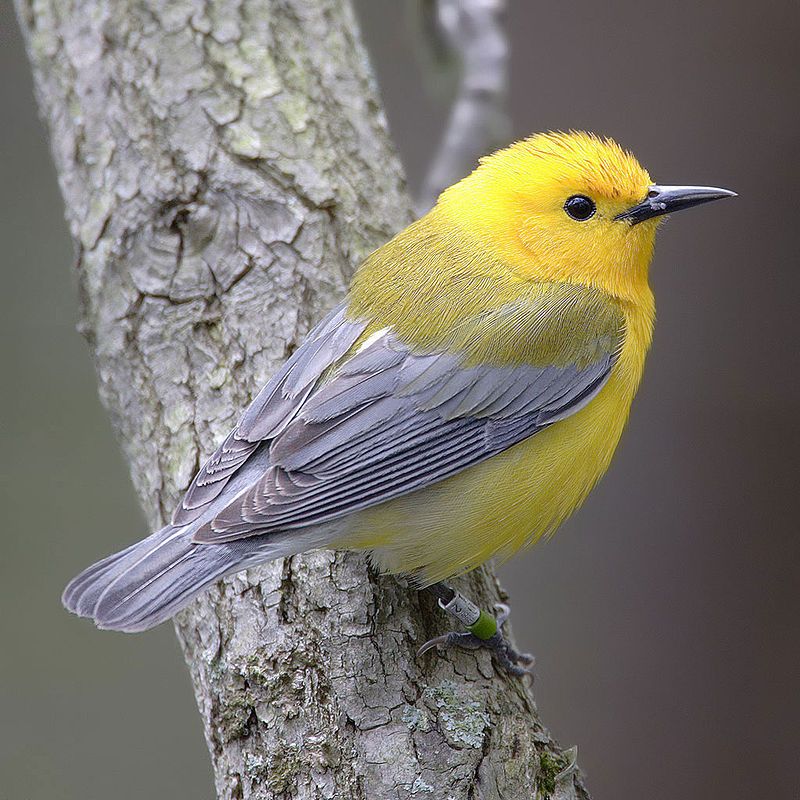
The New World warblers, also known as wood-warblers, are a group of small, brightly colored birds that are members of the family Parulidae.
These birds are only found in the New World, which is the Americas and are not related to the Old World warblers or the Australian warblers. These birds vary in size, shape, and color, although most have a small slim body, with a long tail, and a short pointed beak.
They usually have bright, colorful plumage, which is often used for camouflage. New World warblers are highly active and often difficult to observe.
They live in a variety of habitats, from open woodlands to dense forests, and can be found in many different parts of North America, Central America, and South America. They feed mainly on insects but also eat fruits and berries.
These birds are important to the ecosystems in which they live, as they help to control insect populations, which can be beneficial to other species.
| Kingdom | Animalia |
| Phylum | Chordata |
| Class | Aves |
| Order | Passeriformes |
| Family | Parulidae |
16. American Robin
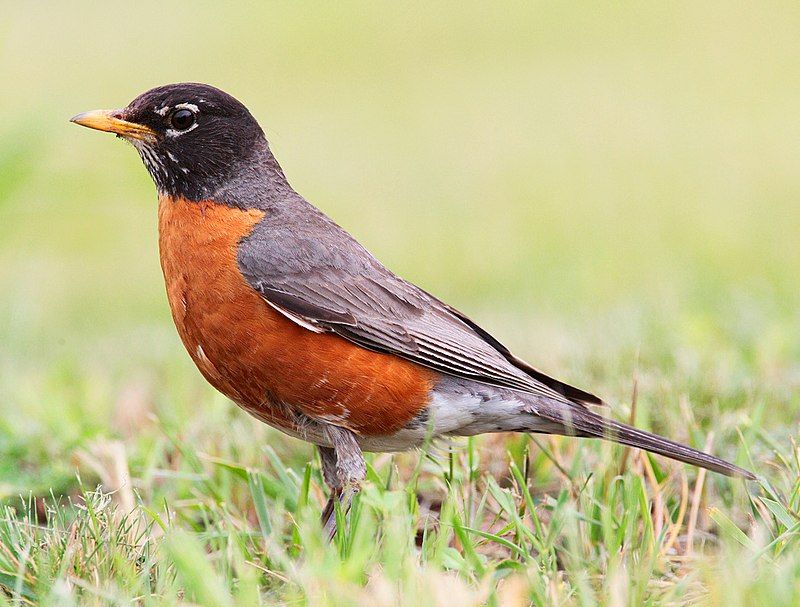
The American robin is a species of migratory bird in the true thrush family and Turdidae, which is a larger family of thrushes. This bird is named after the European robin due to its distinctive reddish-orange breast.
However, these two species are not closely related, as the European robin belongs to the Old World flycatcher family. This shows that although the two birds may look similar, they are in fact two very different species.
The American robin is found across many parts of North America, where it can be seen in both urban and rural areas. It is an omnivore, feeding on both insects and fruit. It is also a popular backyard bird, especially during the winter months.
The American robin is a species that is very important to its environment, as it helps to control insect populations and spread seeds.
| Kingdom | Animalia |
| Phylum | Chordata |
| Class | Aves |
| Order | Passeriformes |
| Family | Turdidae |
| Genus | Turdus |
| Species | T. migratorius |
17. Northern Parula
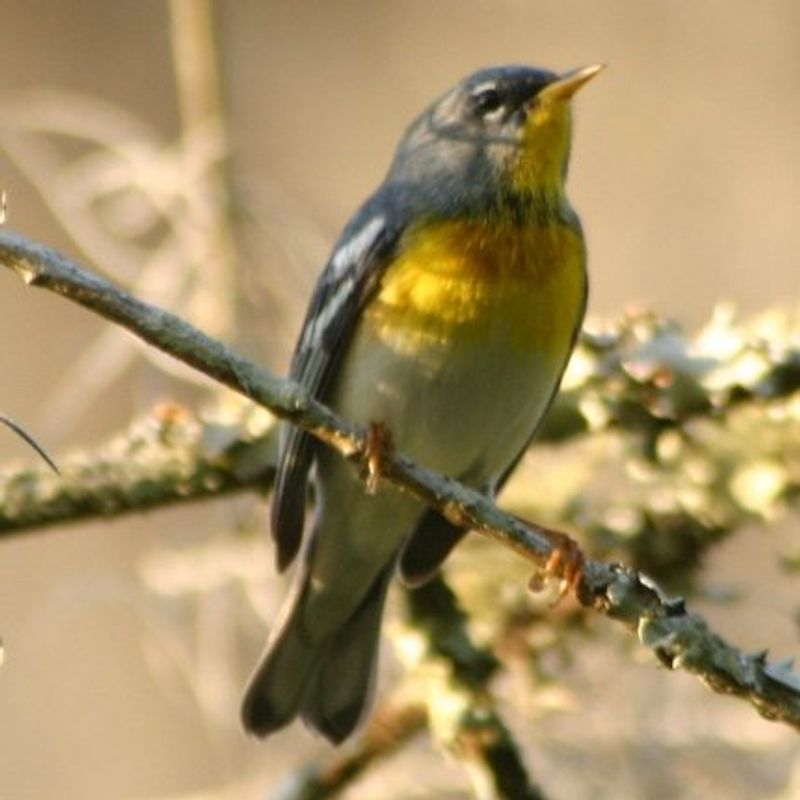
The northern parula is a species of small songbird belonging to the New World Warbler family. It is found in various parts of eastern North America, from the Canadian provinces of southern Canada all the way down to Florida.
It is a migratory species, spending parts of the year in its breeding grounds and other parts of the year in its wintering grounds.
During the breeding season, the northern parula is an olive-green color above and yellow-green beneath, with a yellow throat and breast and two white wing bars. Its song is a series of high-pitched, whistled notes.
Breeding habitats for the northern parula include deciduous and coniferous woodlands, edges of swamps, and shrubby areas. It typically nests in a cup-shaped nest made from plant fibers, moss, rootlets, and spider webs, and it typically lays four to five eggs.
Its diet consists mainly of insects and other invertebrates, which it forages from the ground and from foliage. It also consumes some fruit and nectar. The northern parula is a common species in its range, and its population is stable.
| Kingdom | Animalia |
| Phylum | Chordata |
| Class | Aves |
| Order | Passeriformes |
| Family | Parulidae |
| Genus | Setophaga |
| Species | S. americana |
18. Belted Kingfisher
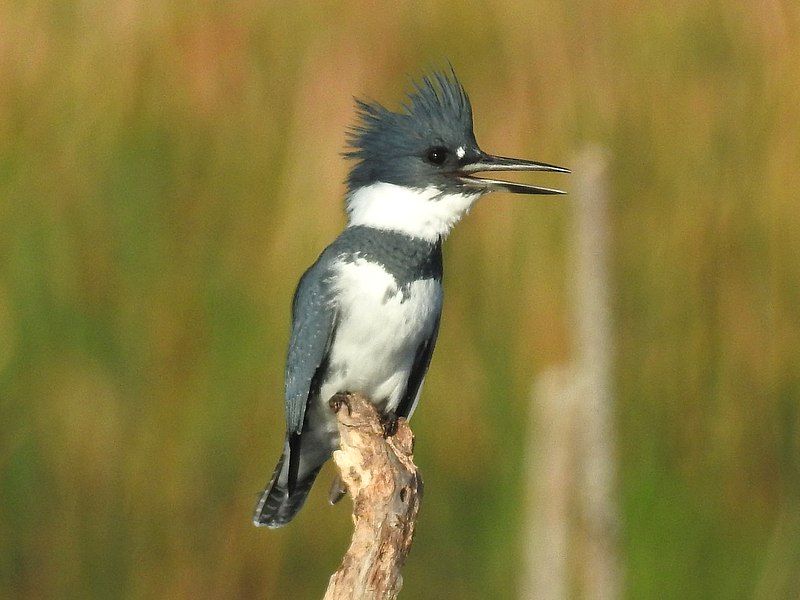
The belted kingfisher is a large, attractive water kingfisher native to North America. It is a member of the Alcedinidae family, which is made up of kingfishers. Until recently, all kingfishers were categorized in the same family.
However, recent research has suggested that the Alcedinidae family should be broken up into three distinct subfamilies. This decision was based on the differences between the various species of kingfishers, with each subfamily containing a specific group of species.
The first subfamily includes the belted kingfisher, as well as the larger American kingfishers. The second subfamily is made up of the small kingfishers found in Asia, Africa, and Australasia, while the third subfamily is made up of the small kingfishers found in the Americas.
By looking at the distinct differences between the species, researchers have been able to draw better conclusions about the evolutionary history of each subfamily.
| Kingdom | Animalia |
| Phylum | Chordata |
| Class | Aves |
| Order | Coraciiformes |
| Family | Alcedinidae |
| Genus | Megaceryle |
| Species | M. alcyon |
19. American Goldfinch
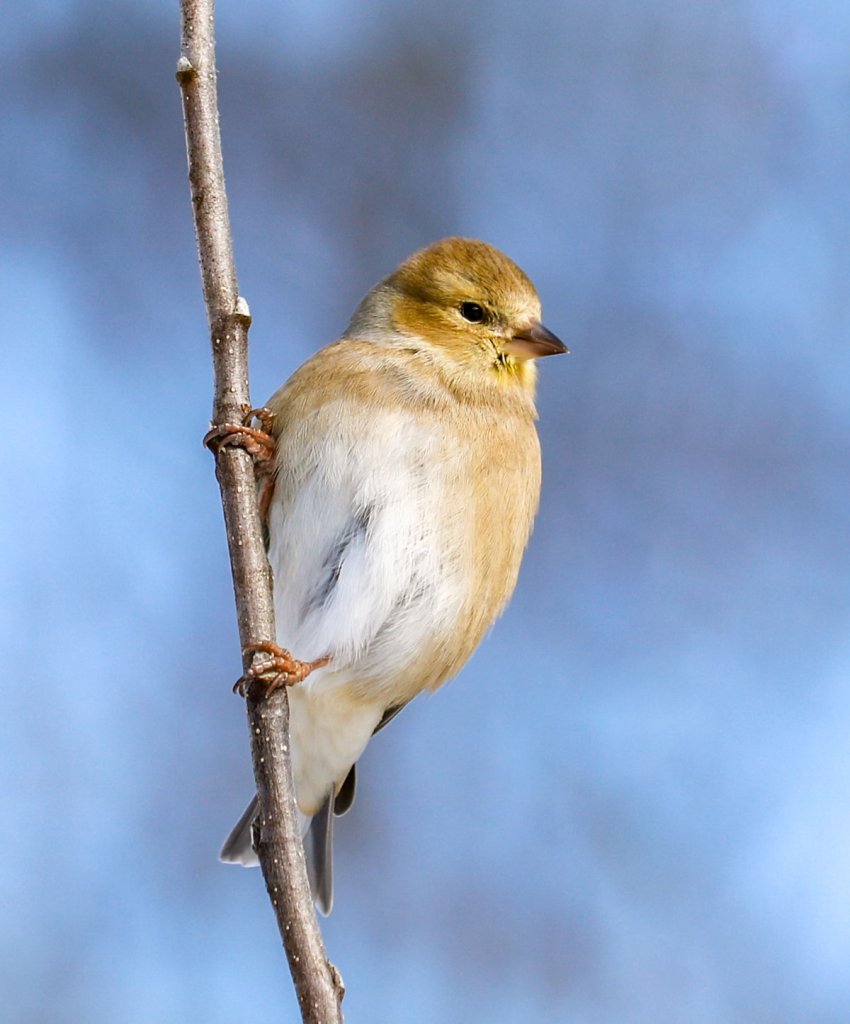
Source: glaszart.com
The American goldfinch is a type of finch that has a wide geographic range throughout North America. It is a migratory bird, meaning that it moves from one area to another based on the season.
During the breeding season, it can be found in the region stretching from mid-Alberta to North Carolina. During the winter, it can be found in an area ranging from just south of the Canada–United States border to Mexico.
This bird usually prefers open areas with shrubs and trees such as fields and meadows, but it can also be found in suburban and urban areas. The American goldfinch is a small bird, measuring around 4.7 inches in length and weighing between 0.5 and 0.7 ounces.
Its upper parts are olive-green and its underparts are yellow with a white patch on its rump. It has a wingspan of around 7.9 inches and a tail length of around 3.5 inches. The American goldfinch feeds mainly on weed seeds, but it also consumes insects, grains, and fruits.
During the breeding season, the male of this species is known for its bright yellow color and its song, which is commonly described as a “potato chip” sound.
| Kingdom | Animalia |
| Phylum | Chordata |
| Class | Aves |
| Order | Passeriformes |
| Family | Fringillidae |
| Genus | Spinus |
| Species | S. tristis |
20. Red-Winged Blackbird
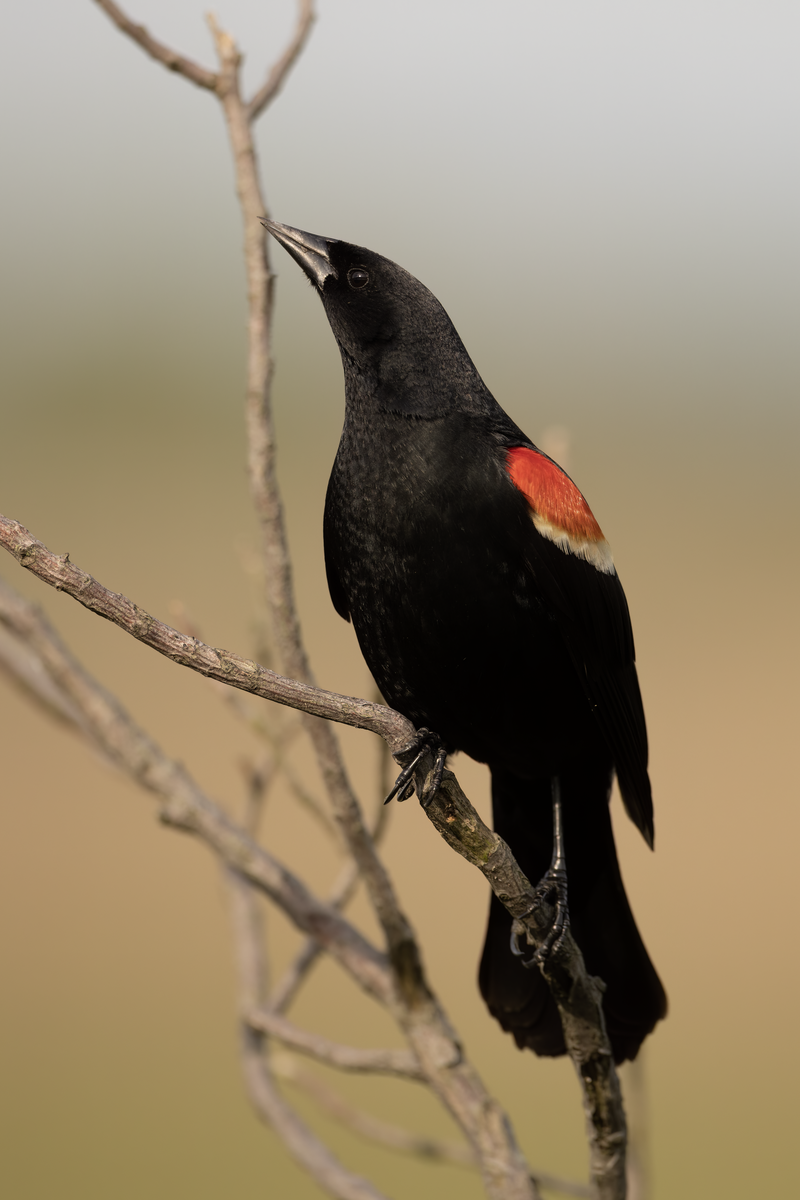
The red-winged blackbird is a type of bird from the family Icteridae that can be found across a large portion of North America and Central America. These birds come in a variety of sizes, with males being slightly larger than females.
They have a glossy black body with distinctive red and yellow patches on their wings and tail feathers. The red-winged blackbird is very vocal and its song is often heard in the spring and summer months.
These birds are omnivorous and can be found foraging for seeds, insects, fruits, and berries. They can be found in a variety of habitats, such as marshes, wetlands, grasslands, and woodlands.
In addition to these habitats, red-winged blackbirds are also found in agricultural areas, such as farm fields and pastures. They are also known to visit bird feeders and can be seen perched atop trees or utility lines.
The red-winged blackbird is a very common species, and its population numbers remain stable as it continues to spread across its range.
| Kingdom | Animalia |
| Phylum | Chordata |
| Class | Aves |
| Order | Passeriformes |
| Family | Icteridae |
| Genus | Agelaius |
| Species | A. phoeniceus |
21. Brown-Headed Cowbird
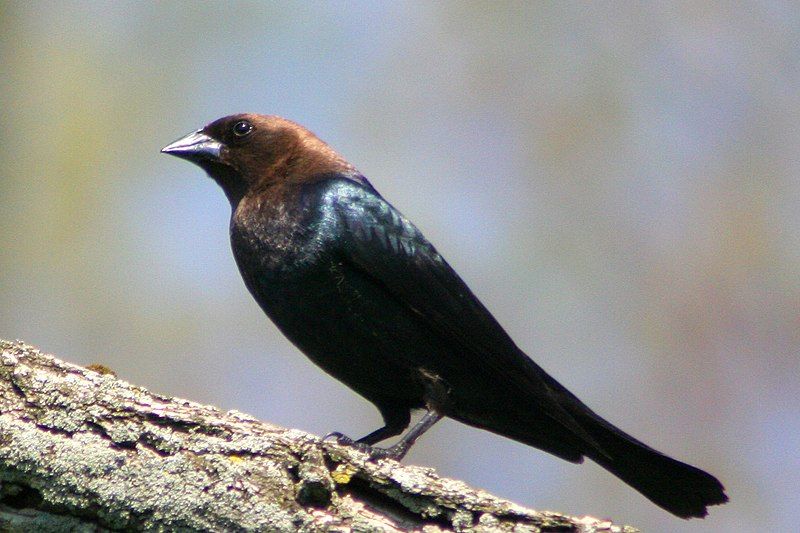
The brown-headed cowbird is a small member of the icterid family, native to North America. It is an obligate brood parasite, meaning that it lays its eggs in the nests of other birds, leaving the host to incubate the eggs and feed the young.
This species is a permanent resident in the southern parts of its range, while northern birds migrate south to the United States and Mexico for the winter. They typically return to their summer habitat in March or April.
This species has adapted to living in a variety of habitats, from grasslands to woodlands and even urban areas. They feed on a variety of seeds, insects, and fruits, and are often seen in flocks foraging on the ground.
The brown-headed cowbird is an important species in the North American avian community, and its migration patterns and reproductive habits have been studied extensively.
| Kingdom | Animalia |
| Phylum | Chordata |
| Class | Aves |
| Order | Passeriformes |
| Family | Icteridae |
| Genus | Molothrus |
| Species | M. ater |
22. Tufted Titmouse
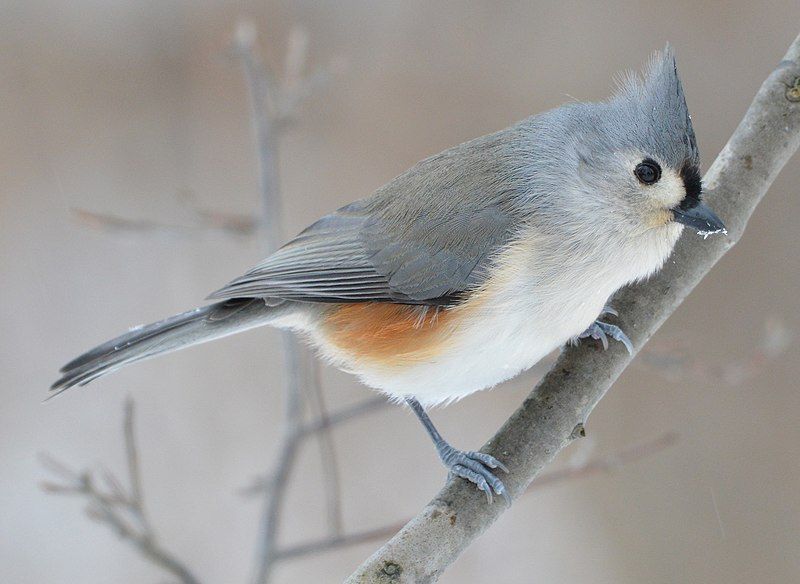
The tufted titmouse is a small songbird that is native to North America. It belongs to the tit and chickadee family, which is a group of birds known for their unique, cheerful songs.
The tufted titmouse is easily recognizable due to its gray and white coloring, and its distinctive black crest on its head. The tufted titmouse used to include a subspecies, the black-crested titmouse, which is found in central and southern Texas.
However, this subspecies is now considered to be its own species, Baeolophus atricristatus. This species has a black crest on its head, instead of the tufted titmouse’s gray and white crest. The black-crested titmouse is also slightly smaller than the tufted titmouse.
Both species of titmice are known to be social creatures, and can often be found in flocks. They are also known to be quite vocal and have a wide range of calls and songs. Both species are important to the local environment, as they help to control the insect population.
| Kingdom | Animalia |
| Phylum | Chordata |
| Class | Aves |
| Order | Passeriformes |
| Family | Paridae |
| Genus | Baeolophus |
| Species | B. bicolor |
23. Gray Catbird
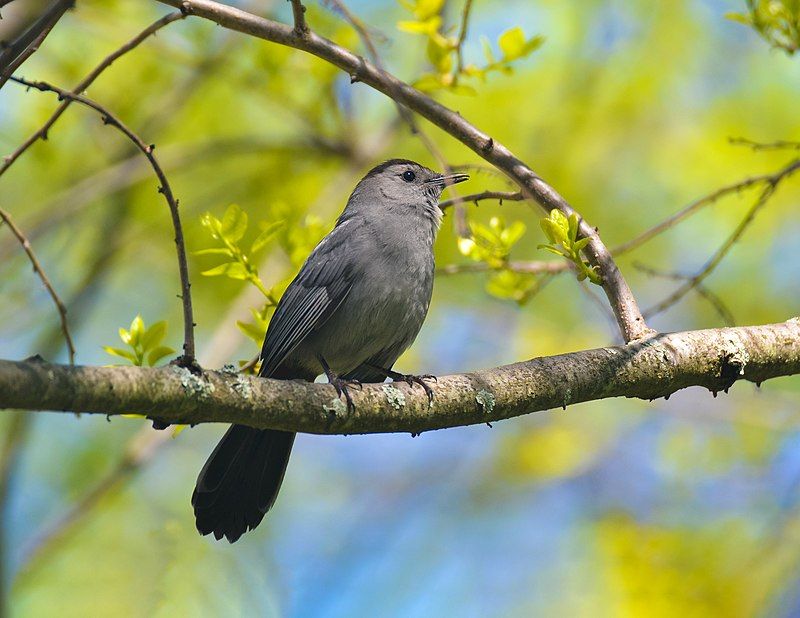
The gray catbird, also spelled grey catbird, is a species of perching bird native to North America and Central America. It belongs to the mimid family, which includes mockingbirds and thrashers. This species is the only one in its genus, Dumetella.
It is a medium-sized bird, typically measuring between 8-9 inches in length. It is generally grey in color with a greyish-brown head, black bill, and white wing patches. Its distinctive call is a loud, meowing sound, similar to a cat.
The gray catbird is usually found around woodland edges, thickets, and other brushy areas. Its diet is mainly composed of insects, fruits, and seeds. It also feeds on small rodents, lizards, and eggs from other birds.
It builds its nest in dense shrubs and trees, using materials such as grass, leaves, and bark. The gray catbird is an important species in its native habitat, often seen in mixed-species flocks with other birds.
It is a popular species among birders and is considered to be a songbird. Although its population is not considered to be threatened, it is important to protect its habitat in order to ensure its long-term survival.
| Kingdom | Animalia |
| Phylum | Chordata |
| Class | Aves |
| Order | Passeriformes |
| Family | Mimidae |
| Genus | Dumetella |
| Species | D. carolinensis |
24. Old World Flycatchers
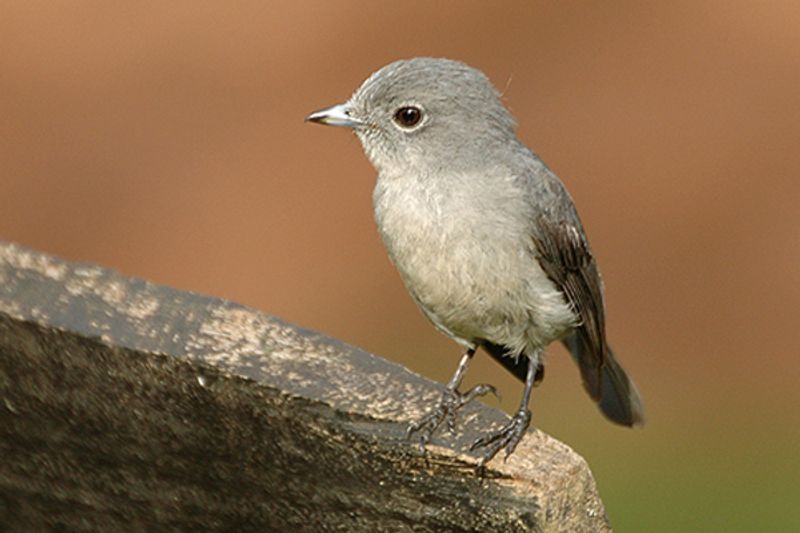
The Old World flycatchers are a family of birds known as the Muscicapidae.
These birds are generally quite small and are found exclusively in the Old World, with the exception of a few vagrant species and two species that have made their way to North America – the bluethroat and northern wheatear.
Flycatchers are a type of passerine bird, which are characterized by their perching and hopping behavior. These birds often have short wings and tails, giving them a distinctive silhouette when they are in flight.
Flycatchers are usually found near bodies of water, as they feed on insects that live near them. They are also quite adept at catching flying insects in mid-air.
The Old World flycatchers play an important role in controlling insect populations, making them a valuable part of the ecosystem.
| Kingdom | Animalia |
| Phylum | Chordata |
| Class | Aves |
| Order | Passeriformes |
| Family | Muscicapidae |
25. Gnatcatcher
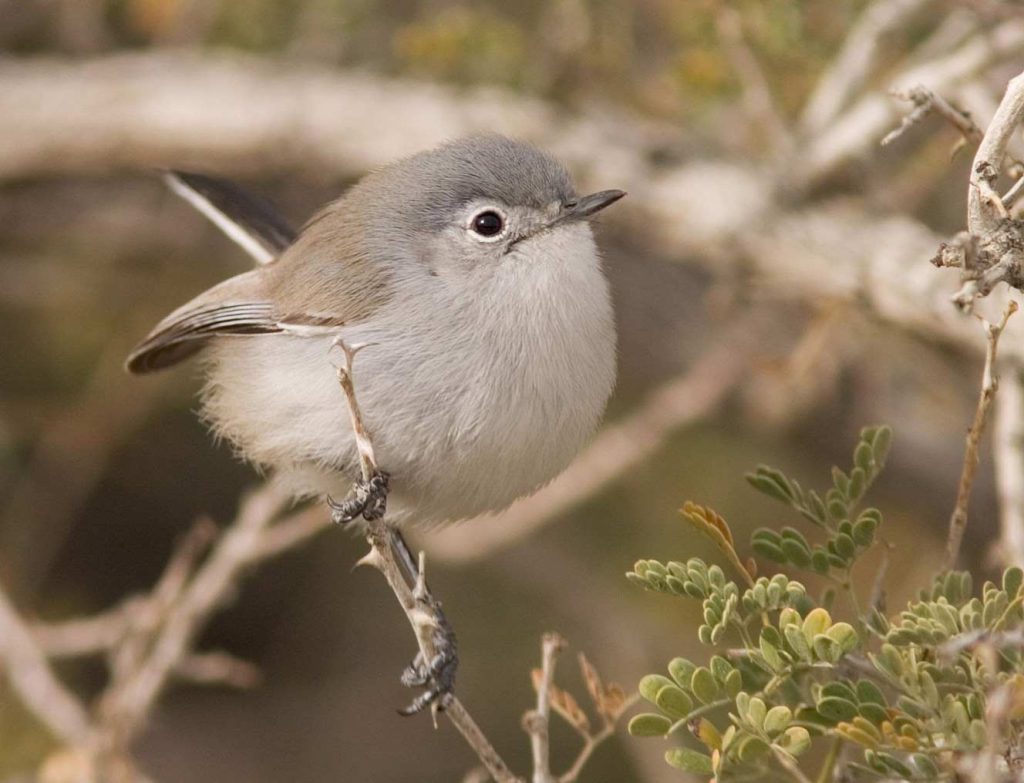
The gnatcatchers are a family of small passerine birds found in North and South America. They are part of the Polioptilidae family, which consists of 21 different species.
The majority of these species are found in tropical and subtropical regions, and they tend to be resident birds, meaning that they do not migrate from one area to another.
However, the blue-grey gnatcatcher, which is native to the United States and southern Canada, migrates south during the winter months. This species of gnatcatcher is particularly unique in its migration patterns, which sets it apart from other members of its family.
While the majority of the gnatcatchers remain in the same areas all year round, the blue-grey gnatcatcher makes a journey south for the winter. This behavior helps the species to survive in colder climates and ensures that the population remains healthy and strong.
| Kingdom | Animalia |
| Phylum | Chordata |
| Class | Aves |
| Order | Passeriformes |
| Family | Polioptilidae |
26. American Purple Gallinule
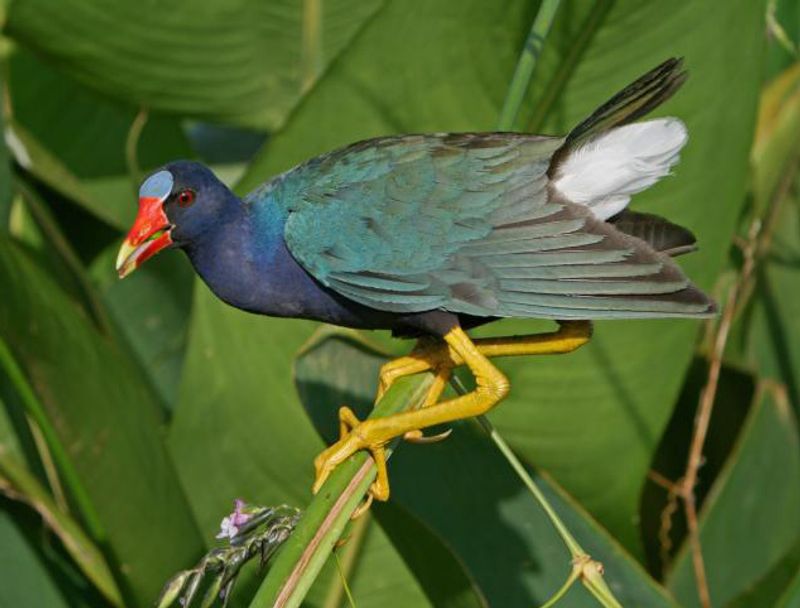
The purple gallinule is a species of swamphen, which is a member of the genus Porphyrio. The purple gallinule belongs to the order Gruiformes, which literally translates to “crane-like”. This order includes many species such as cranes, rails, and crakes.
Specifically, the purple gallinule is classified as a rail species, placing it into the family Rallidae. Locally, the purple gallinule is also known as the yellow-legged gallinule.
The purple gallinule is a colorful bird, with a bright, glossy purple head and neck, and green and yellow feathers on its back. Its bill is red, and its legs are yellow. It can be found in a variety of wetland habitats, such as marshes, lakes, ponds, and swamps.
It is a ground feeder, eating a wide variety of aquatic plants, insects, small fish, and crustaceans. The purple gallinule often nests in dense vegetation near water, and is usually seen in small groups.
Overall, the purple gallinule is an interesting species of swamphen, belonging to the order Gruiformes and the family Rallidae. It is brightly colored and can be found in wetland habitats, foraging for food on the ground.
It nests in dense vegetation and is usually seen in small flocks.
| Kingdom | Animalia |
| Phylum | Chordata |
| Class | Aves |
| Order | Gruiformes |
| Family | Rallidae |
| Genus | Porphyrio |
| Species | P. martinicus |
27. Great Blue Heron
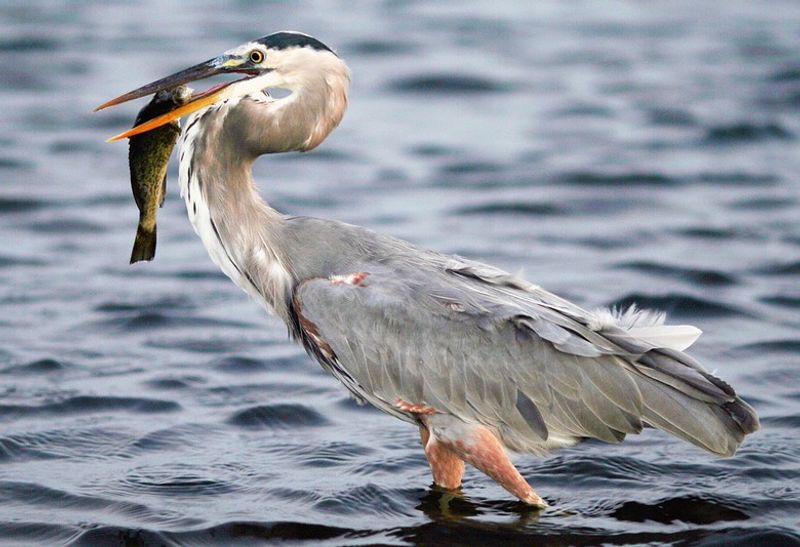
The great blue heron is a majestic bird, easily identifiable by its size and striking blue-grey color. It belongs to the heron family Ardeidae, which is found throughout North and Central America, from the Caribbean to South America, and even the Galápagos Islands.
They can be found in a variety of habitats, from wetlands to open water along the shoreline. The great blue heron is an impressive bird, standing up to four feet tall and boasting an impressive wingspan of six feet.
They are usually solitary birds but sometimes are seen in small groups wading through shallow waters.
They are opportunistic feeders, often searching for small fish, crustaceans, amphibians, reptiles, and even small mammals. The great blue heron has a long and slender neck that it uses to reach into the depths of the water.
It has long, thin legs and a broad, rounded wingspan that it uses to soar gracefully through the air. Its feathers are a stunning slate blue-grey color that stands out against the backdrop of its natural habitats.
The great blue heron is an incredible sight to behold, and its presence is proof of the beauty and power of nature. Its ability to thrive in a variety of habitats makes it a resilient species, and its majestic beauty is a reminder of our shared connection to the natural world.
| Kingdom | Animalia |
| Phylum | Chordata |
| Class | Aves |
| Order | Pelecaniformes |
| Family | Ardeidae |
| Genus | Ardea |
| Species | A. herodias |
28. Little blue heron
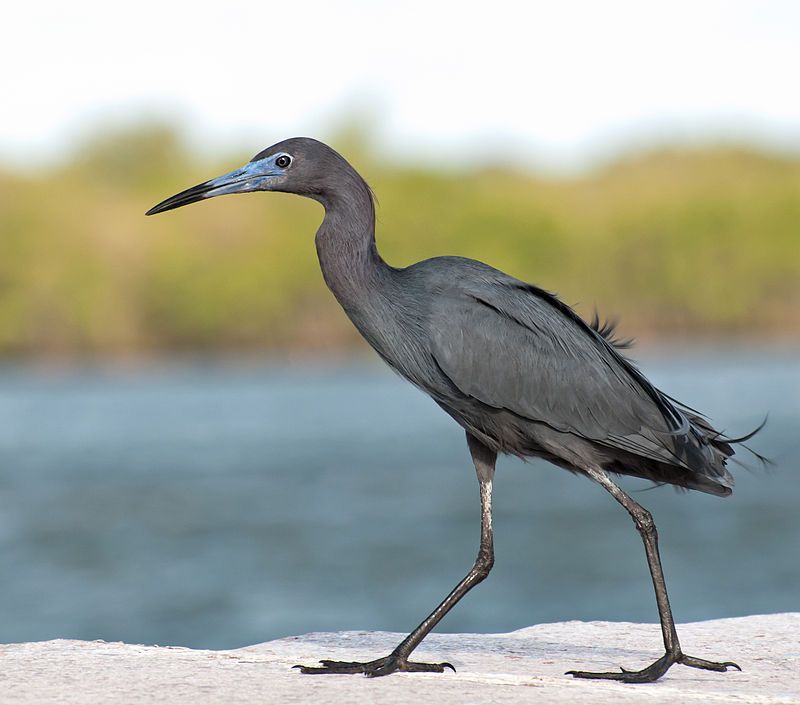
The little blue heron is a small heron of the genus Egretta. It is mainly dark blue in color, with a two-toned bill that is black and yellow. Juveniles of this species are entirely white, making them look very similar to the snowy egret.
During the breeding season, adults will develop different coloration on their heads, legs, and feet, with shades of dark blue, green, and even yellow. This coloration helps them to attract a mate and show off their strength and vigor.
The little blue heron’s diet consists mainly of small fish, frogs, and insects. They are often seen wading in shallow waters, waiting to snatch up their prey. It is an elegant bird that is a pleasure to watch in action.
| Kingdom | Animalia |
| Phylum | Chordata |
| Class | Aves |
| Order | Pelecaniformes |
| Family | Ardeidae |
| Genus | Egretta |
| Species | E. caerulea |
29. Cliff Swallow
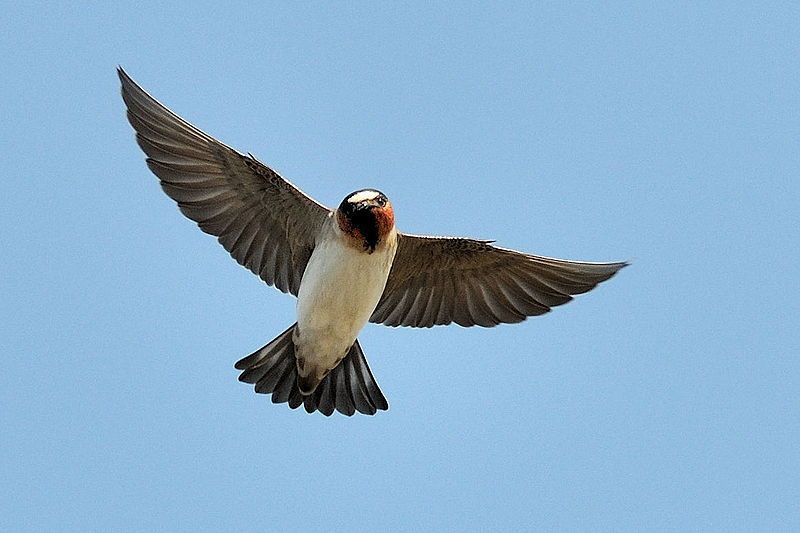
The cliff swallow, also known as the American cliff swallow, is a species of bird that belongs to the family Hirundinidae, which is a group of passerines known as swallows and martins.
This species is small in size, with adults typically measuring from 5.5 to 6.3 inches in length, and weighing between 0.7 and 1.1 ounces. They have a wingspan of about 8.3 inches and their plumage is mostly brown and white.
Cliff swallows are migratory birds and can be found in open areas, such as near streams, ponds, and wetlands, throughout much of North America. They feed on flying insects and are usually seen flying close to the ground, searching for food.
During the breeding season, they build nests of mud and saliva, which are attached to the sides of cliffs, bridges, and buildings. The female usually lays two to six eggs, which both parents take turns incubating.
The cliff swallow is a social species, often forming large colonies of nesting birds. These colonies can number in the hundreds and may contain other species of swallows and martins.
This species is a medium-sized bird of conservation concern and is listed as vulnerable in the IUCN Red List of Threatened Species due to losses of nesting sites and habitat destruction.
| Kingdom | Animalia |
| Phylum | Chordata |
| Class | Aves |
| Order | Passeriformes |
| Family | Hirundinidae |
| Genus | Petrochelidon |
| Species | P. pyrrhonota |
30. Double-Crested Cormorant
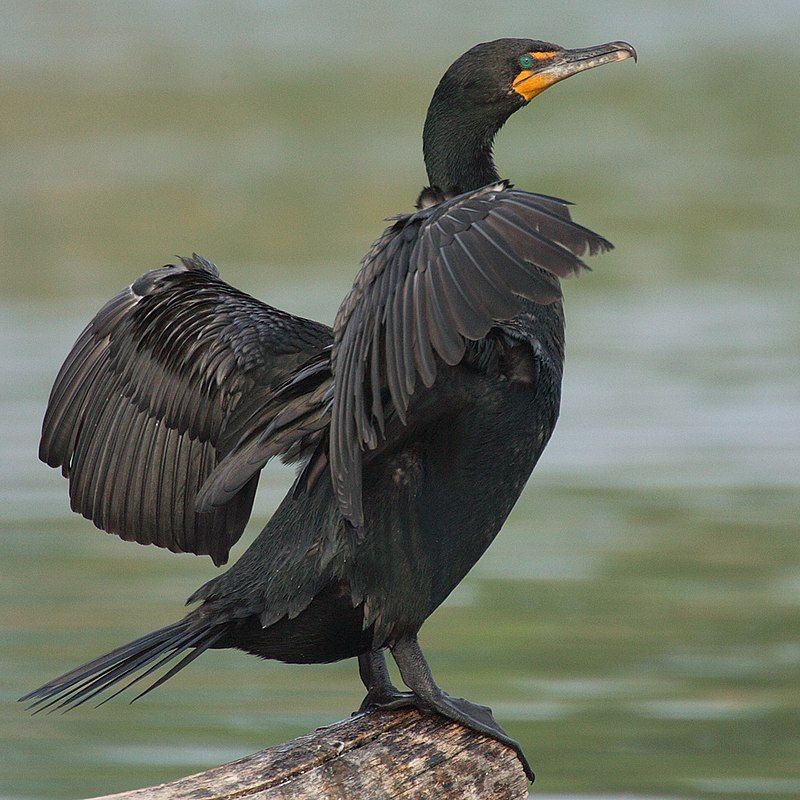
The double-crested cormorant is a species of water bird in the cormorant family. They are found in a variety of environments, both inland and coastal, including rivers, lakes, and the ocean.
This species of cormorant is found all across North America, from Alaska’s Aleutian Islands in the north to Florida and Mexico in the south.
They are a very widespread species and can be found in many different habitats. The double-crested cormorant is typically a medium to large-sized bird. They have a grey-brown back and a white underside, with a dark grey head and neck.
They also have a distinctive double crest of black feathers on the back of their head. Their wings are long and pointed, and they have a long, hooked bill. The double-crested cormorant feeds on a variety of fish, including trout, carp, and catfish.
They dive underwater to catch their prey, using their feet to propel them through the water. They often hunt in groups and are highly vocal when doing so. The double-crested cormorant is a social species, often found in large colonies near food sources.
They build their nests in trees, usually near water, and the female will lay up to four eggs. The chicks are born blind and helpless and are fed by both parents. The double-crested cormorant is an important species in ecosystems across North America.
They help to keep the fish population in check and also provide food for other species such as ospreys, eagles, and gulls. They are also a popular species for birdwatchers, as they are easy to spot and can often be seen in large groups.
| Kingdom | Animalia |
| Phylum | Chordata |
| Class | Aves |
| Order | Suliformes |
| Family | Phalacrocoracidae |
| Genus | Nannopterum |
| Species | N. auritum |
Conclusion
In conclusion, bluebirds in Indiana are an important part of the state’s wildlife. They are a keystone species, helping to maintain the balance of the ecosystem and providing food and shelter to other species.
They are also a symbol of hope for those who take joy in the beauty of nature. The Indiana Department of Natural Resources works to protect and preserve their habitat so that Indiana’s blue birds can continue to thrive for generations to come.